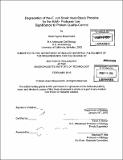Degradation of the E. coli small heat-shock proteins by the AAA+ protease lon : significance to protein quality-control
Author(s)
Bissonnette, Sarah Ayano
DownloadFull printable version (12.49Mb)
Other Contributors
Massachusetts Institute of Technology. Dept. of Biology.
Advisor
Tania A. Baker.
Terms of use
Metadata
Show full item recordAbstract
The refolding and elimination of damaged and aggregated proteins requires the concerted effort of several branches of the protein quality-control network. This network includes refolding chaperones, disaggregases, holdases and proteases. Many years of investigation have led to a partial understanding of how different branches of the protein quality-control network cooperate with each other to accomplish the critical task of refolding or eliminating damaged and aggregated proteins. Here we investigate cooperation between the Lon protease and the IbpA and lbpB small heat-shock protein (sHSP) holdases in the model organism, Escherichia coli. sHSPs are molecular chaperones that bind unfolded proteins and prevent their irreversible aggregation. sHSPs contain a central a-crystallin domain flanked by variable N- and C-terminal tails. These tails are responsible for the higher-order oligomerization, and therefore the chaperone functions, of sHSPs. The E. coli genome contains two sHSPs, ibpA and ibpB. We find that IbpA and lbpB are substrates of the Lon protease when in their free form, and also when they are bound to unfolded client proteins in vivo and in vitro. Interestingly, unlike other known substrates of AAA+ proteases, lbpA and lbpB seem to be recognized through a structural feature of their conserved a-crystallin domain, rather than through peptide motifs near their N- or C-termini. (cont.) Furthermore, we find that IbpB facilitates the degradation of lbpA both in vivo and in vitro, and that the mechanism by which IbpB stimulates IbpA degradation is most likely through directly interacting with lbpA and making IbpA a better substrate, rather than by activating Lon and making Lon better able to degrade IbpA. Finally we investigate the importance of the degradation of lbps that are bound to aggregated client proteins and find that degradation of client-bound Ibps by Lon facilitates the refolding of lbp-bound clients. These data therefore uncover a previously undescribed connection between the proteolytic branch and the holdase branch of the protein quality-control network. Furthermore, this work demonstrates that in addition to being important for the degradation of damaged or misfolded proteins, proteolysis also has a novel role in the refolding of aggregated proteins.
Description
Thesis (Ph. D.)--Massachusetts Institute of Technology, Dept. of Biology, 2010. "February 2010." Cataloged from PDF version of thesis. Includes bibliographical references (p. 118-127).
Date issued
2010Department
Massachusetts Institute of Technology. Department of BiologyPublisher
Massachusetts Institute of Technology
Keywords
Biology.